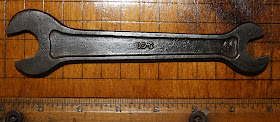Oddball size, measuring .520" across the flats on one side and .700 on the other. Note the logo stamped on it:

On the reverse, the name badge:
 |
| Source: Smithsonian National Museum of American History. |
The Beverly plant boasted such modern inventions as the first time-clocks produced by IBM, the hot glue gun, the pop top for the soda can, the drive mechanism for the lunar module, as well as pop rivets used in the Supersonic Concorde. The company even had its own Atomic Power division. Its British division, BUSM, produced a variety of military items during both world wars, including naval gun sights and the the technically very demanding precision cast wheelhouse for the Rolls-Royce Merlin aircraft engine. After the war, BUSM was an early adopter of numerical control machines, installing a prototype Kearns horizontal boring machine that is now on display at the Manchester Institute of Technology. Back in the US, the government anti-trust efforts finally resulted in the break-up of the company in the 1960's. Management responded by diversifying, buying up various companies which only added on debt. A crash followed: stock that was valued at $56 per share in 1968 was worth only $18 in 1972. In 1976 the company was bought by the Emhart Corporation, an organization half USMC's size and which itself was subsequently acquired by Black and Decker in 1989. Its old factory in Beverley is now a commercial property managed by Cummings Properties and is described as the oldest continually used commercial real estate in the U.S. According to their website, "Since its purchase of the property in 1996, Cummings Properties has worked closely with Beverly Historical Society to preserve much of The Shoe's rich history. Throughout the property a wide variety of artifacts is displayed, including refurbished antique USM equipment/machinery, dozens of wall-mounted vintage photo enlargements, an original IBM time clock used at The Shoe in the early 1900s, and several other items donated or loaned by residents of Beverly and the surrounding community." The Cummings website gives a fascinating insight into the architectural approaches of the time ("building as machine") as well as the many historically significant aspects of the USMC factory. They have an open house once a year. Sounds worth a visit.
As for The Shoe, it continues to do business as USM.






When was the Montreal factory of USMC in operation?
ReplyDeleteStill going! http://www.usm-americas.com/who-we-are/index.html
ReplyDelete